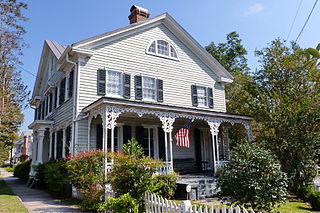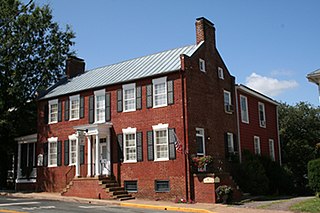
The Turner and Amelia Smith House is a historic home in Willow Spring, Wake County, North Carolina, a suburb of Raleigh. The house was built about 1880, and is a two-story, three-bay, single-pile frame I-house with a central hall plan. It is sheathed in weatherboard, has a triple-A-roof, and a tall shed addition and hip-roofed front porch.

The John Smith House is an historic building located in Le Claire, Iowa, United States. The house has been listed on the National Register of Historic Places since 1979. The property is part of the Houses Houses of Mississippi River Men Thematic Resource, which covers the homes of men from LeClaire who worked on the Mississippi River as riverboat captains, pilots, builders and owners.

John Calvin Wilson House is a historic home located near Indiantown, Williamsburg County, South Carolina. It was built about 1847, and is a two-story, five bay, frame central-hall plan I-house. It features a shed roofed, one-story "Carolina" or "rain porch" supported by four stuccoed brick columns. A one-story frame rear wing was added in 1939. John Calvin Wilson was a politician and a successful planter. He died at Richmond, Virginia of complications from a thigh wound sustained in the Battle of Cold Harbor.

Bower-Cox House is a historic house located on SR 1595 southwest of Scottville, Ashe County, North Carolina. It is locally significant for its association with its builder and owners.

John Bunyan Green Farm is a historic home and farm and national historic district located near Midland, Cabarrus County, North Carolina. The district encompasses 12 contributing buildings, 2 contributing sites, and 1 contributing structure. The farmhouse was built about 1880, and is a two-story, frame dwelling with Italianate style design elements. It features a two-story gabled front porch, a gable roof, and two exterior end chimneys. Also on the property are the contributing ten outbuildings, well canopy, the Garmon Mill site, the miller's house, and the fields and woods.

Miller–Cansler House, also known as the Adam Miller Jr. House, is a historic home located near Maiden, Catawba County, North Carolina. It was built about 1820, and is a two-story, frame Federal style farmhouse. It features a full-width shed-roofed porch. A one-story frame ell was added in 1941.

Smith-Whitford House is a historic home located at New Bern, Craven County, North Carolina. It was built about 1772, and is a two-story, five bay, central hall plan, Georgian style frame dwelling. The front entrance was recessed and shallow porch added during the Late Victorian period.

Clifton House and Mill Site is a historic home and grist mill site located near Royal, Franklin County, North Carolina. It was built in the 1850s, and is a two-story, rectangular frame house with a hipped roof in the Greek Revival style with Italianate design elements. It features a two-story pedimented front porch and has a two-story rear ell. Also on the property are two contributing 19th-century outbuildings, Miller's House, and the ruins of a grist mill built about 1831, including some machinery.

William Rankin and Elizabeth Wharton Smith House is a historic home located near Whitsett, Guilford County, North Carolina. It consists of a one-story, side-gable-roofed, hall-parlor dwelling built about 1846, with a room added about 1854, and two-room ell with a full-length porch to the rear about 1885. The Coastal Cottage form dwelling has Greek Revival style design elements. The house was moved to its present location, about 6/10th of a mile from its original site, in June 2005.

Woodstock is a historic plantation house located near Scotland Neck, Halifax County, North Carolina. The earliest section dates to about 1783, and is a two-story, vernacular frame dwelling with later rear additions. It was expanded in the mid-19th century to a romantic villa house three bays wide and two large bays deep with a shallow gable roof and one-story full-width front porch. The house is set in a formal landscape designed by Joseph B. Cheshire.

Smith-Williams-Durham Boarding House was a historic boarding house located at Hendersonville, Henderson County, North Carolina. It was built about 1909, and was raised to two-stories and remodeled in 1918. It was a rambling frame former dwelling with Classical Revival style design elements. It had a low hipped roof with extended and bracketed eaves and a single tiered wraparound porch. It has been demolished.

Robert L. Blalock House is a historic home located at Kinston, Lenoir County, North Carolina. It consists of the original two-story, three bay, double-pile, side-hall-plan Greek Revival style main block dated to the 1850s, and a large, two-story rear ell. It has a one-story gable-roofed wing and a small shed-roofed room north of the rear ell and a complex arrangement of one- and two-story additions and enclosed porches to the south. The house was renovated in the 1920s in the Classical Revival style. It features a full-width front porch supported by groups of square-section brick columns with a round corner pavilion and porte-cochère. It has housed a funeral home since 1947.

Cedar Dell, also known as Kennedy Memorial Home, is a historic plantation house located near Falling Creek, Lenoir County, North Carolina. It was originally constructed about 1820 as a two-story, three bay, Federal style brick dwelling with a side-hall plan. It was enlarged to five bays wide and converted to a Victorian Gothic central hall plan mansion. The front facade features a one-story Eastlake-style porch with a low roof topped by a wrought iron balustrade and the rear facade has a two-tier porch. Also on the front facade is a large bay window with a roof identical to that on the porch. The house and property were deeded for use as an orphanage in 1912.

Liddell-McNinch House is a historic home located at Charlotte, Mecklenburg County, North Carolina. It was built between 1891 and 1893, and is a 2 1/2-story, Queen Anne / Shingle Style frame dwelling. The house has a highly complex roofline of projections, gables, porches, and spreading eaves, and wall surfaces of weatherboards, shingles, broken planes, swells, and cavities. It features a wraparound porch and a recessed porch on the second level. President William Howard Taft visited the McNinch House in 1909.

Isaac White House, also known as the Thomas White House, was a historic home located near Bethel, Perquimans County, North Carolina. It was built about 1716, and was a two-story, three bay, hall-and-parlor plan frame house with semi-engaged, two-tier porch. It had a side gable roof, and featured flanking gable end brick chimneys with steep double shoulders. The house has been moved to 612 Holiday Island Road in Hertford NC, and is being restored by Down East Preservation and Old Town Wood Floors.

John Steele House, also known as Lombardy, is a historic plantation house located at Salisbury, Rowan County, North Carolina. It was built between 1799 and 1801, and is a two-story, three bay, side hall plan, Federal style frame dwelling. It has a side gable roof, one-story shed roof porch, and is sheathed with beaded weatherboards. The house was restored between 1977 and 1983. It was the home of North Carolina politician John Steele (1764-1815).

Edenwood, also known as the Smith-Williams House, is a historic home located near Garner, Wake County, North Carolina. The original section of the house dates to the early-19th century. About 1850, a frame Greek Revival-style I-house was added. A two-story frame wing was added about 1935. A center-bay two-story pedimented porch flanked by one-story, full-facade, attached porches were added to the front facade in the 1930s. Also on the property is a contributing outbuilding.

Edmondson-Woodward House is a historic plantation house located near Stantonsburg, Wilson County, North Carolina. It was built about 1830, and is a two-story, three bay, single pile, "L"-plan, Federal style frame dwelling. It has a two-story wing added in the mid-19th century, side gable roof, exterior end chimneys, and hipped-roof porch with flared columns.

The Dr. Ezekiel Ezra Smith House is a historic house at 135 South Blount Street in Fayetteville, North Carolina. It is a 2-1/2 story wood frame structure, with complex massing typical of the Queen Anne architectural style. Its main block has a side gable roof, with a projecting bay section at the right of the front facade that is topped by a gable. A hip roof porch extends from the center of the projecting bay around to the left side. The house was built in 1902, and is unusual as a Queen Anne house in one of the city's historical African-American neighborhoods. Dr. Ezekiel Ezra Smith, for whom the house was built, was instrumental in the development of North Carolina's first State Colored Normal School, established in Fayetteville in 1877.

The Carter-Simmons House is a historic house at 218 Coy Smith Road, near Albertson, North Carolina. It is a 1-1/2 story wood frame structure with an integral front porch, three bays wide, with several types of exterior wood coverings, a product of its unusual construction history. The house was built in the early 19th century as a two-story wood frame structure, and was reduced in 1853 to its present size by the removal its upper floor. It is one of the best-preserved examples of this type of coastal cottage to be found in Duplin County.


















